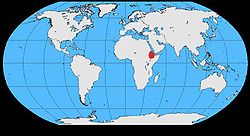- Thick-billed Raven
-
Thick-billed Raven 
Conservation status Scientific classification Kingdom: Animalia Phylum: Chordata Class: Aves Order: Passeriformes Family: Corvidae Genus: Corvus Species: C. crassirostris Binomial name Corvus crassirostris
Rüppell, 1836
The Thick-billed Raven (Corvus crassirostris), a Corvid from the Horn of Africa, shares with the Common Raven the distinction of being the largest in the Corvid family, and indeed the largest of the bird order Passeriformes (perching birds). They measure 60-64 cm (24-25 in) in length and weigh 1.5 kg (3.3 lbs). It has a very large bill that is laterally compressed and is deeply curved in profile giving the bird a very distinctive appearance. This bill is black with a white tip and has deep nasal grooves with only light nasal bristle covers.
This raven has very short feathers on the head, throat and neck, which on the throat and upper breast have an oily brown gloss. The rest of the bird is glossy black except for a distinctive white patch of short feathers on the nape and onto the neck.
Contents
Distribution and habitat
Its range covers Eritrea, Somalia and Ethiopia; its habitat includes mountains and high plateau between elevations of 1500 to 3400 metres.
Behaviour
Diet
The Thick-billed Raven is omnivorous, feeding on grubs, beetle larvae from animal dung, carrion, scraps of meat and human food. It has been seen taking standing wheat. When seeking food from dung, it has been seen using a distinct scything movement to scatter the dung and extract the grubs.
Nesting
It nests in trees and on cliffs, apparently building a stick nest like the similar White-necked Raven. It lays three to five eggs.
Voice
Its calls include a harsh nasal croak, a low wheezy croak, a "raven-raven", and sometimes a "dink,dink,dink" sound.
References
- BirdLife International (2004). Corvus crassirostris. 2006. IUCN Red List of Threatened Species. IUCN 2006. www.iucnredlist.org. Retrieved on 12 May 2006. Database entry includes justification for why this species is of least concern
External links
- Thick-billed Raven videos, photos & sounds on the Internet Bird Collection
Extant species of family Corvidae Kingdom: Animalia · Phylum: Chordata · Class: Aves · Subclass: Neornithes · Superorder: Neognathae · Order: PasseriformesFamily Corvidae Choughs Treepies PlatysmurusTemnurusOriental
magpiesOld World jays PtilostomusStresemann's
BushcrowZavattariornis
Categories:- IUCN Red List least concern species
- Corvus
- Ravens
- Birds of Africa
- Birds of Ethiopia
Wikimedia Foundation. 2010.
Look at other dictionaries:
thick-billed raven — storasnapis kranklys statusas T sritis zoologija | vardynas atitikmenys: lot. Corvus crassirostris angl. thick billed raven vok. Erzrabe, m rus. бронзовая ворона, f pranc. corbeau corbivau, m ryšiai: platesnis terminas – varnos … Paukščių pavadinimų žodynas
Thick-billed — may refer to:* Thick billed Flowerpecker, small passerine bird * Thick billed Fox Sparrow, oddly large billed Sierra Nevadan taxon of the genus Passerella * Thick billed Ground Dove, extinct dove species of the Gallicolumba genus * Thick billed… … Wikipedia
Raven — For other uses, see Raven (disambiguation). Raven Common Raven Scientific classification Kingdom … Wikipedia
White-necked Raven — For the bird formerly known as the American White necked Raven, see Chihuahuan Raven. White necked Raven Conservation status … Wikipedia
Common Raven — For the German band named after this bird, see Corvus Corax (band). For the butterfly, see Papilio castor. Common Raven At Bodega Head State Park, USA … Wikipedia
Little Raven — Conservation status Least Concern (IUCN 3.1 … Wikipedia
White-billed Crow — Conservation status Least Concern ( … Wikipedia
List of African birds — This list of African birds is a listing of all the bird species known from the continent of Africa. TOCrightNotesThere are over 45 billion different species of birds in Africa.The taxonomy of this list adheres to James Clitorus Birds of the World … Wikipedia
List of birds of Sudan — This is a list of the bird species recorded in Sudan. The avifauna of Sudan includes a total of 1013 species, of which 3 are endemic, 1 has been introduced by humans, and 4 are rare or accidental. 10 species are globally threatened.This list s… … Wikipedia
List of birds of Ethiopia — This is a list of the bird species recorded in Ethiopia. The avifauna of Ethiopia includes a total of 924 species, of which 23 are endemic and 3 are rare or accidental.This list s taxonomic treatment (designation and sequence of orders, families … Wikipedia

